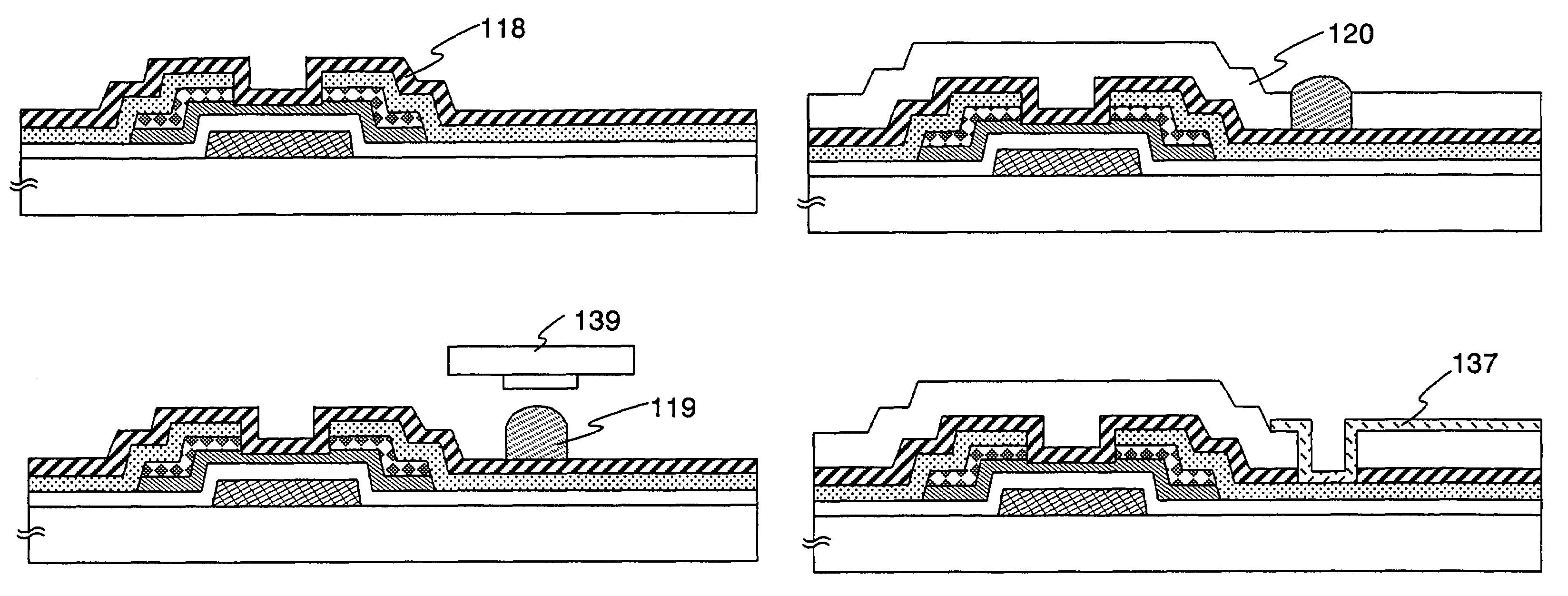Fabrication method of a semiconductor device using liquid repellent film
a technology of liquid repellent film and semiconductor device, which is applied in the direction of optics, instruments, transistors, etc., can solve the problems of contact defect, and achieve the effects of good contact hole, reduced process complexity, and improved contact hole quality
- Summary
- Abstract
- Description
- Claims
- Application Information
AI Technical Summary
Benefits of technology
Problems solved by technology
Method used
Image
Examples
embodiment mode 1
[0040]In this embodiment mode, the case of applying the present invention to the fabrication of an inverted staggered (bottom gate type) TFT will be described with reference to FIGS. 1A to 3C.
[0041]First, a gate electrode 104 and a scan line 105 supplying a signal to the gate electrode 104 is formed over the substrate 100. It is preferable that the gate electrode 104 and the scan line 105 are formed over the substrate 100 by selectively discharging each composition containing a conductive material. In this case, etching using a mask pattern is not required, so that the number of the fabrication process can be significantly simplified.
[0042]The diameter of nozzles 102 used as a liquid discharge means is each set at 0.1 μm to 50 μm (preferably, 0.6 μm to 26 μm), and the discharge amount of the composition discharged from the nozzles 102 is each set at 0.00001 pl to 50 pl (preferably, 0.0001 pl to 10 pl). The discharge amount increases in proportion with the diameters of the nozzles 10...
embodiment mode 2
[0092]In this embodiment mode, the case of applying the invention to the fabrication of a top gate TFT will be described with reference to FIGS. 4A to 5D.
[0093]First, a semiconductor film 401 is formed over the substrate 100 having an insulating surface. The substrate 100 may use a substrate formed of an insulating material such as glass, quartz, or alumina; or metal such as stainless steel or a semiconductor substrate whose surface is provided with an insulating film of such as silicon oxide, silicon nitride, or the like. Alternatively, a flexible or nonflexible plastic substrate which is heat resistant so as to endure the highest processing temperature in this process such as a baking temperature of the pattern formed by a droplet discharge method, or a heat treatment temperature of activation of impurities doped into a source and a drain regions of the semiconductor device.
[0094]The semiconductor film 401 is formed of an amorphous semiconductor, a crystalline semiconductor, or a ...
embodiment 1
[0116]In this embodiment, the fabrication method of an active matrix substrate with the use of the invention will be described with reference to FIG. 6A to FIG. 8B. In particular, the case of using PVA for first organic films and using polyimide or acrylic for a second organic film in order to form contact holes will be described.
[0117]First, a base insulating film 601 is formed over a substrate 600. Here, a silicon oxynitride film (SiNO) is formed to a thickness of 10 nm to 200 nm by plasma CVD to form the base insulating film 601. The material of the base insulating film 601 is not limited to SiNO, and a silicon film oxide, a silicon nitride film, or a silicon oxynitride film; or a stack thereof may be used. Further, the base insulating film 601 is not necessarily formed.
[0118]Next, a semiconductor film is formed to a thickness of 10 nm to 80 nm over the base insulating film 601. The surface of the semiconductor film is treated with a solution containing nickel, and a crystalline ...
PUM
| Property | Measurement | Unit |
|---|---|---|
| diameter | aaaaa | aaaaa |
| diameter | aaaaa | aaaaa |
| distance | aaaaa | aaaaa |
Abstract
Description
Claims
Application Information
 Login to View More
Login to View More - R&D
- Intellectual Property
- Life Sciences
- Materials
- Tech Scout
- Unparalleled Data Quality
- Higher Quality Content
- 60% Fewer Hallucinations
Browse by: Latest US Patents, China's latest patents, Technical Efficacy Thesaurus, Application Domain, Technology Topic, Popular Technical Reports.
© 2025 PatSnap. All rights reserved.Legal|Privacy policy|Modern Slavery Act Transparency Statement|Sitemap|About US| Contact US: help@patsnap.com



